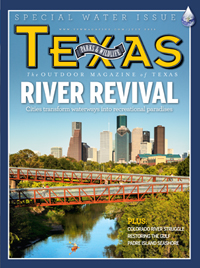
The ABC's of H2O
Breaking down key terms of water issues.
By John S. Merculief II
I’ve always loved the sound of a babbling brook, the gentle way it whispers the many secrets of the uplands. Truth be told, water has a language all its own. From artesian wells to recharge zones, wading into discussions on water issues can be daunting for those unschooled in the lingo.
Here’s a simple look at some key terms used in today’s water talk.
Aquifer: A layer of rock or sand that can absorb and hold water. Examples include the Edwards Aquifer, which stretches from Brackettville through San Antonio to South Austin; and the Ogallala Aquifer, a massive multistate formation that extends through the western Panhandle, including the Amarillo area, Lubbock and Midland. Aquifers provide water for millions of people, as well as for crops and livestock.
Groundwater: Water that occurs below the surface of the earth, where it occupies spaces in soils or geologic strata. Most groundwater comes from precipitation, and typically, 10 percent to 20 percent of precipitation eventually enters aquifers. Groundwater is distinct from surface water, which flows (or sits) on the ground, in rivers, creeks, streams, etc. Groundwater and surface water are the most common sources of drinking water.
Hydrology: A science dealing with the properties, distribution and circulation of water, both on and below the Earth’s surface and in the atmosphere. State agencies including the Texas Parks and Wildlife Department and the Texas Commission on Environmental Quality use hydrology to ensure their water conservation efforts are grounded in science, not speculation. Hydrology helps us understand our role in the water cycle.
Riparian: Relating to, or living or located on, the bank of a natural watercourse (such as a river). The immediate environment of just about any river, creek or babbling brook counts as riparian — except perhaps the developments of the San Antonio River Walk. The health of a watercourse is closely related to the quality of its riparian areas.
Watershed: The area of land where all the water that falls upon it drains to the same river, stream, lake or estuary. The Rio Grande’s watershed includes the Pecos River. Watersheds are a key element of the hydrologic cycle, the process of rain falling on land, running off to streams and lakes and eventually evaporating to become rain clouds.
Recharge zone: An area where water flows into an aquifer.
Artesian well: A place in the ground where water flows to the surface through natural pressure.
Water footprint: A measure of the amount of water used, both directly and indirectly, to produce consumer goods and services.
Hydrologic cycle: The continuous movement of water on, above and below the surface of the Earth, where it can take the form of liquid, vapor or ice.
» Like this story? If you enjoy reading articles like this, subscribe to Texas Parks & Wildlife magazine.
Related stories
Where the First Raindrop Falls
For more on water, check out TPWD's State of Water, with water-related videos, magazine articles and other resources.

